
The Birmingham Small Arms Company Limited (BSA) was a major British industrial combine, a group of businesses manufacturing military and sporting firearms; bicycles; motorcycles; cars; buses and bodies; steel; iron castings; hand, power, and machine tools; coal cleaning and handling plants; sintered metals; and hard chrome process.
Birmingham is one of England's principal industrial centres and has a history of industrial and scientific innovation. It was once known as 'city of a thousand trades' and in 1791, Arthur Young described Birmingham as "the first manufacturing town in the world". Right up until the mid-19th century Birmingham was regarded as the prime industrial urban town in Britain and perhaps the world, the town's rivals were more specific in their trade bases. Mills and foundries across the world were helped along by the advances in steam power and engineering that were taking place in the city. The town offered a vast array of industries and was the world's leading manufacturer of metal ware, although this was by no means the only trade flourishing in the town.
Lucas Industries plc was a Birmingham-based British manufacturer of motor industry and aerospace industry components. Once prominent, it was listed on the London Stock Exchange and was formerly a constituent of the FTSE 100 Index. In August 1996, Lucas merged with the American Varity Corporation to form LucasVarity.

The Gun Quarter is a district of the city of Birmingham, England, which was for many years a centre of the world's gun-manufacturing industry, specialising in the production of military firearms and sporting guns. It is an industrial area to the north of the city centre, bounded by Steelhouse Lane, Shadwell Street and Loveday Street.
The Birmingham pen trade evolved in the Birmingham Jewellery Quarter and its surrounding area in the 19th century; for many years, the city was the centre of the world's pen trade, with most dip pens being produced there. At the height of the Jewellery Quarter's operations, there were about 100 pen factories, which employed around 8,000 skilled craftspeople.

Swaine London, known previously as Swaine Adeney Brigg, is a luxury goods shop that has traded in London's St James's since 1798. The shop sells leather goods, Brigg umbrellas and hats from Herbert Johnson.
John Ainsworth Dunn was an American furniture maker.

Whangee refers to any of over forty Asian grasses of the genus Phyllostachys, a genus of bamboos. They are a hardy evergreen plant from Japan, China, and the Himalayas whose woody stems are sometimes used to make canes and umbrella handles. The word derives from the Chinese (Mandarin) huáng lí. It can also refer to a cane made from whangee.
Heal's is a British furniture and homeware retail company comprising seven stores, selling a range of furniture, lighting and home accessories. The business was started in 1810 by John Harris Heal, and its headquarters have been located in Tottenham Court Road since 1818. Under Sir Ambrose Heal, the company introduced Arts and Craft style to mechanised furniture production, making it available to the middle classes. In 2001, an official guide to the archive at the Victoria & Albert Museum, wrote that for over two centuries Heal's had been known for promoting modern design and for employing talented young designers. Since 2001, the business has been owned by Wittington Investments, a company owned by the Weston family.
Dunlop Ltd. was a British multinational company involved in the manufacture of various natural rubber goods. Its business was founded in 1889 by Harvey du Cros and he involved John Boyd Dunlop who had re-invented and developed the first pneumatic tyre. It was one of the first multinationals, and under du Cros and, after him, under Eric Geddes, grew to be one of the largest British industrial companies. J. B. Dunlop had dropped any ties to it well before his name was used for any part of the business. The business and manufactory was founded in Upper Stephens Street in Dublin. A plaque marks the site, which is now part of the head office of the Irish multinational departments store brand, Dunnes Stores.
Edward Preston & Sons is a tool manufacturer based in Birmingham, England.
Coloroll is a United Kingdom wallpaper brand owned by CWV Ltd.
Originally known as Stephenson and Meldrum (1921–1937), Stephenson and Turner (1938–1995) was a prominent Australian architectural firm, best known for the pioneering modernism of their numerous hospital designs of the 1930s and 1940s.
Bétaille was a luxury umbrella manufacturer in Paris. The boutique was located at rue Royale 5 from 1880 to 1939. The goodwill and stock of the firm were bought out by Thomas Brigg & Sons in 1919.
Founded in the 1780s, Köhler & Son were independent makers of brasswind instruments in London until they were bought by Swaine & Adeney in 1907.
Thomas Brigg & Sons, said to have been founded in 1836, were makers of umbrellas and canes in London. They merged with the London firm of Swaine & Adeney to form Swaine, Adeney, Brigg & Sons Ltd in 1943.

Herbert Johnson is a London firm of hatters and cap makers. Founded in 1889 at 45 New Bond Street, the business was bought by the London firm of Swaine Adeney Brigg in 1996.
Papworth Industries was the name given to the manufacturing arm of Papworth Village Settlement, a Cambridgeshire colony for sufferers of tuberculosis founded in 1916. The luggage and travel-goods division was bought by the London firm of Swaine Adeney Brigg in 1997.

Thomas Walker & Son were inventors and makers of nautical instruments in the 19th and 20th centuries. The firm made one of the most commonly used navigation instruments, the 'log' which allowed sailors to measure distance at sea, one of the main measurements used in nautical navigation. The firm was founded by Thomas Walker in Birmingham in the 1830s.
George G. Bussey & Co., founded 1864 by George Gibson Bussey, was a manufacturer of hunting, cricket, tennis, polo, croquet, football, and rugby equipment.